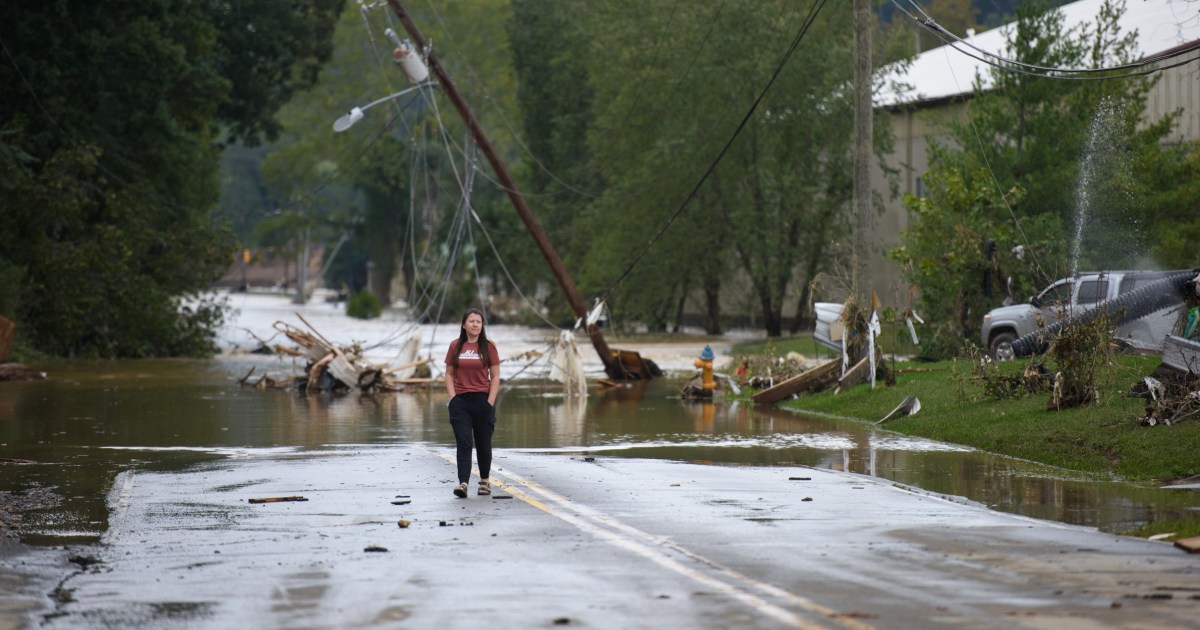Before Hurricane Helene began ravaging swaths of the southeastern U.S., Amanda Wright had expected a little rain and maybe some flooding to hit the area around Knoxville, Tennessee, where she lives.
It wasn’t until friends more than two hours away in Asheville, North Carolina, started posting warnings to Facebook that Wright realized how dangerous the storm could be.
“It seems like you just never really know who to believe,” Wright, 32, said. “There’s so much information out there that you don’t really know who to trust.”
Wright and millions of other Americans face an information ecosystem far different from the 1950s, when the U.S. government started making public predictions of hazardous weather. And despite advancements in the science of forecasting and the introduction of smartphones that can deliver accurate warnings directly to users, the urgency of such warnings can often get lost in rapid-fire social media feeds or be undercut by widespread skepticism of the government and the media.
Hurricane Helene’s deadly path took shape days before the Category 4 storm made landfall in Florida’s Big Bend region late on Thursday, Sept. 26.
Scientists with the National Weather Service and the National Hurricane Center began sounding the alarm as early as Sept. 23. In a YouTube video posted that morning, the National Hurricane Center’s deputy director, Jamie Rhome, described a tropical cyclone that would “briskly develop” into a hurricane. Monday night, the National Weather Service posted on X that heavy rain and powerful wind gusts would hit the Southeast later in the week.
On Wednesday, the National Weather Service sent out a “rare” news release urging the media to continue focusing on the catastrophic nature of Hurricane Helene. It was part of a broader strategy to connect directly with the public and leverage relationships with local governments and media partners, said David Novak, director of the NWS’ Weather Prediction Center.
That day, North Carolina’s governor declared a state of emergency, as did Buncombe County, which had already begun seeing heavy rains and warning of dire storm conditions and would be one of the hardest-counties in the state.
“It is not common for the National Weather Service to use words like ‘catastrophic’ to describe forecasts,” Buncombe County Manager Avril Pinder said at a news conference Thursday morning. “When they do that, we should all take heed.”
The situation had grown so dire that on Thursday, the sheriff in Taylor County, Florida, grimly asked residents who did not heed evacuation orders to write their names and Social Security numbers on their bodies so officials could later identify them should they not survive.
“I have no doubt that these accurate forecasts saved lives and property,” Novak said.
Most people, he said, “did take this seriously.”
Still, more than 130 people were killed in the storm across six states, according to a tally from NBC News. Officials said at least 57 of those deaths occurred in Buncombe County, hundreds of miles away from where the storm made landfall.
In the heart of Asheville, which is part of Buncombe County, Mae Creadick, 52, said local officials had warned residents about the storm through text messages, but she and her neighbors did not believe it could destroy the area, so she and her family stayed put.
But on Monday, as the city became “apocalyptic,” they scoured the house for $15 in spare change, siphoned the gas out of her son’s car and drove 90 miles before finding normalcy in Columbia, South Carolina.
“Many people in the mountains probably didn’t heed the warnings because this has never happened here to this extent,” she said. “If warnings were not heeded or adequate warnings were not given, it’s because this is so unprecedented.”
In Tennessee, where at least eight people have died, Wright shared the same sentiment. “We didn’t ever think that anything like this could happen,” she said. The storm, she said, was a “wake-up call for a lot of people.”
Part of the challenge for authorities and forecasters is communicating the links between extreme weather and climate change. That has made even apolitical groups like the National Oceanic and Atmospheric Administration (NOAA) and the National Weather Service a target of some Republicans.
Former President Donald Trump said at a rally on Sunday, while talking about Helene, that climate change is “one of the great scams.” Project 2025, a conservative policy roadmap for another Trump term, includes language that calls NOAA a part of the “climate change alarm industry” and that it “should be broken up and downsized.” It also says that the National Weather Service, part of NOAA, should focus on data gathering and “commercialize its forecasting operations.” Trump has disavowed that plan, though many of his key allies were involved in it.
Kelli Burns, an associate professor of communications at the University of South Florida, said the loss of trust between citizens and government agencies and the media creates a kind of paradox.
“Everything is politicized today — even hurricane warnings,” she said, adding that meteorologists and reporters must walk a fine line to avoid stoking panic while also clearly communicating the risks to keep people safe.
Meanwhile, the distrust in traditional institutions “leads us to possibly make bad decisions or disregard information that could potentially save our lives,” Burns said.
Chris Gloninger, a meteorologist and climate scientist, stepped back last year from a television career because of harassment he had received in reaction to his coverage of climate change and its impact on weather. Gloninger noted that dire warnings were issued last week for many parts of North Carolina, and that weather forecasting has improved in recent years. But better forecasts were now competing for attention with social media and ideology-driven perspectives, he said.
“Even with all of the accuracy, even with all of the tools and technology, even as we’re becoming better communicators over time, with that social science, technical science, coming together, finding those best practices, we’re still dealing with this fringe part of society that there’s a ton of oxygen that they have,” he said. “And it kind of fuels this misinformation, disinformation, and I’d argue that that’s one of the most challenging things that we have to counter.”
Gloninger added that false claims about the storm related to fringe conspiracy theories seemed to be a new element. Some people used the moment to push the false idea that the storm was the result of a government-made “weather modification weapon.”
“This was truly the first event that I’ve seen with a certain part of the population spreading misinformation about geoengineering, weather modification,” Gloninger said. “And it’s mind blowing.”
Another conspiracy theory that gained some traction alleged that lithium mining interests had altered the course and severity of the storm to wipe out local opposition to mining. Such claims on X and TikTok accrued millions of views.
An account on X belonging to a self-described video analyst for rare weather phenomena promoted the lithium-related conspiracy theory, with one post about it receiving 2.3 million views. But the post contradicted itself: It said that there was a lithium deposit “under the ground of Asheville” then acknowledged that the deposit is in fact 70 miles away in Kings Mountain, North Carolina.
Yotam Ophir, an associate professor at the University of Buffalo who studies political and science communication, said that severe weather events have traditionally attracted misinformation and conspiracy theories, but that the modern information ecosystem now makes it easier for outlandish claims to find audiences who are often anxious for explanations.
Now, he said, that has combined with a decline in trust in institutions like the government and mainstream media to create a challenging environment for news consumers and legitimate sources of information.
“I don’t think that individuals have the tools to identify truth and deception in such complicated topics,” Ophir said. “And we need to restore trust in those that do know how to do it.”






